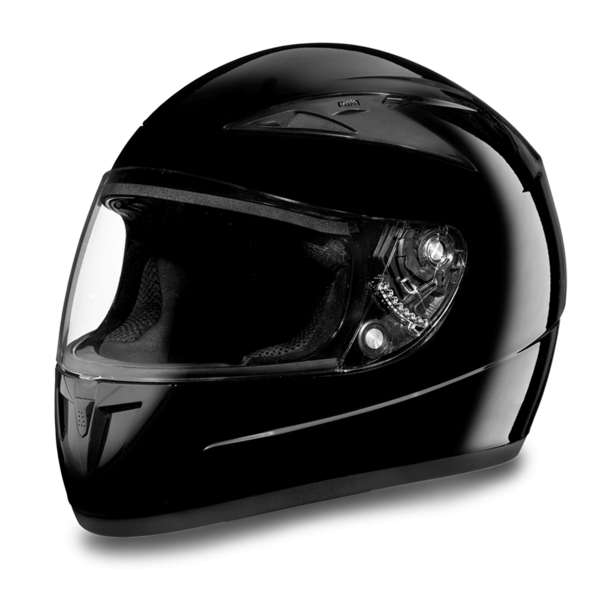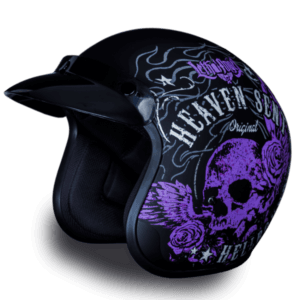Not only is it important to choose between full-face and open-face helmets while looking for the right motorcycle helmet, but it is also important to have a solid understanding of how the various helmet designs correspond to your own riding requirements. In order to assist you in making the most appropriate choice, let’s discuss a few essential factors.
1. The kind of motorcycle
When it comes to choosing a helmet, the kind of motorbike you ride is a significant factor to consider. Full-face helmets are often the helmet of choice for sportbike riders because of the requirement for optimum protection when traveling at high speeds. At greater speeds, the rider is protected from the wind thanks to the aerodynamic design, which matches the riding posture of a sportbike and reduces the amount of resistance that the wind presents.
On the other hand, open-face helmets are typically far more popular among scooter riders and cruiser riders. The relaxed and upright riding position of a cruiser is a perfect complement for the classic style and comfort that open-face helmets offer. It is possible that the open design of this helmet style is more suitable for your ride if you are riding at modest speeds or if you are confined to urban surroundings.
D.O.T Retro Motorcycle Full Face Helmet
2. The Environment of Riding
You should also consider the terrain you intend to bike on while selecting a helmet. When traveling on the highway or over long distances, when the road conditions might change quickly and safety is of the utmost importance, full-face helmets are the best wearable option. By providing shelter from road debris, dust, and insects, which are common on roads, the enclosed design helps reduce fatigue caused by wind resistance and gives protection from these elements.
It is possible that an open-face helmet will provide you with greater comfort if the majority of your riding takes place in urban areas or at slower speeds. It is possible that riders who are navigating through traffic in the city would appreciate the ease of communication and visibility that an open-face helmet provides. In addition, the lower weight and improved airflow make commuting in the city a more pleasurable experience.
3. Conditions of the Weather
Take into account the weather conditions that you will be cycling in. Full-face helmets are frequently the helmet of choice for riders who have to ride in conditions that are either uncertain or unpleasant. You are protected from the elements, including wind, rain, and cold temperatures, by the whole enclosure, which ensures that you are not exposed to the elements during extended rides.
Open-face helmets are frequently chosen by riders who live in hot or tropical locations because of the increased ventilation they provide. The ventilation helps to keep you cool, and the open design alleviates the feeling of being suffocated and constricted that can be associated with wearing full-face helmets when the temperature is high. On the other hand, it is essential to keep in mind that this comes at the sacrifice of facial protection.
D.O.T. Daytona Heaven Sent Cruiser Motorcycle 3/4 Helmet
4. The Length of the Trip
The duration of your rides is another factor that may influence your choice. Even though it is heavier, a full-face helmet is commonly considered to be more comfortable for long-distance riders over the course of their riding career. Its reduced wind noise, improved aerodynamics, and protection from the elements make it an excellent option for riders who spend a significant amount of time on the road on their motorcycles.
An open-face helmet could be more practical for shorter journeys, particularly those that take place within the city or to destinations in the immediate vicinity. It is less cumbersome because of its smaller weight and easier access to fresh air, which is especially beneficial when you are often getting on and off your bike throughout the day.
What to Look for in a Motorcycle Helmet in Order to Meet all Safety Standards
No matter whether you go for a full-face or an open-face helmet, the most important thing you should always keep in mind is your own personal safety. It is imperative that every helmet on the market satisfies the basic safety requirements that have been set forth by regulatory agencies. A few important certifications to keep an eye out for are as follows:
D.O.T. Daytona Dull Black Cruiser Motorcycle 3/4 Helmet
1. Department of Transportation (often known as DOT)
The Department of Transportation (DOT) certification of helmets in the United States assures that they are up to the minimal safety criteria for usage on roads. All motorcycle helmets are required by law to have this certification, which verifies that the helmet has successfully undergone fundamental impact and penetration testing.
2. economic commission for Europe (also known as ECE)
There are almost fifty nations throughout the world that recognize the ECE certification process. The Department of Transportation (DOT) has lower safety criteria than the helmets that have this certification. Certifications such as the ECE 22.05 and the more recent ECE 22.06 are frequently sought for by riders who are looking for the highest possible level of protection.
D.O.T German Motorcycle Helmet – Gloss Black
3. SNELL
By establishing more strict testing methods for helmets than either the Department of Transportation or the European Commission, the SNELL Memorial Foundation is a private, non-profit organization. If your helmet has a SNELL certification, it means that it has been put through a series of rigorous tests, which include multiple impact locations and higher-energy hits.
It is imperative that you constantly examine the label of the helmet you intend to purchase for these certifications. This will ensure that you are selecting a helmet that offers dependable protection.
Further Considerations to Take into Account
Contemporary motorcycle helmets offer a variety of features that enhance your riding experience, in addition to providing safety and a stylish appearance. With regard to comfort, convenience, and usefulness, they can make a major impact in the whole experience.
1. Bluetooth compatibility is the first.
This technology enables riders to connect their cellphones to their helmets, enabling them to engage in hands-free conversation, GPS navigation, and music streaming. Many of the more recent helmets, particularly full-face models, come equipped with Bluetooth technology. There is no longer a requirement to use earphones or to stop and check your phone when riding for extended periods of time thanks to this feature, which can improve both safety and enjoyment.
D.O.T German Motorcycle Helmet – Dull Black
2. Pinlock Anti-Fog System
It is not uncommon for fog to form, especially when the temperature is lower or when there is a significant level of humidity present. There is a secondary visor that is included in helmets that have a Pinlock visor system. This visor prevents fog from accumulating, ensuring that the wearer has good vision at all times. Despite the fact that this function is typically found in full-face helmets, it is also possible to include it into some open-face variants.
3. Lining and padding that can be removed
The interiors of helmets have the potential to gather perspiration and filth over time. Helmets that include linings that can be removed and washed make maintenance much simpler, ensuring that your helmet will remain clean and sanitary at all times. Not only is this function beneficial for full-face helmets as well as open-face helmets, but it is especially helpful for riders who ride frequently.
4. Helmets that are modular offers a versatile option
If you are divided between the protection that a full-face helmet provides and the ventilation that an open-face helmet provides, a modular helmet might help you find the ideal compromise between the two. A flip-up chin bar is a characteristic of modular helmets, which enables riders to switch from full-face to open-face protection depending on the situation. Because of their adaptability, they are perfect for touring riders who do lengthy excursions and want both options available to them.
Are you going to have an open face or a full face?
It is impossible to provide a conclusive response to the question of whether full-face or open-face helmets are superior. The riding style, environment, comfort preferences, and safety requirements that you have will determine which helmet is the best option for you. The full-face helmet is without a doubt the superior option for riders who place a high priority on optimum protection, aerodynamics, and noise reduction. If, on the other hand, you value freedom, ventilation, and style, then the open-face helmet might be a better fit for your riding experience.
Regardless of the helmet you decide to purchase, you should always put safety first by making sure you wear a DOT certified helmet as it satisfies the standards required by the industry and that it fits you correctly. Making the appropriate decision when it comes to your helmet is the most important piece of safety equipment you own; it can be the difference between a ride that is safe and one that is deadly.





